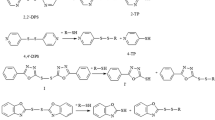Summary
Cystinuria, an inborn error of metabolism, is clinically characterized by the formation of l-cystine crystals and stones in the urinary tract. Sulfhydryl compounds react with the less soluble cystine to form water-soluble disulfide derivatives. l-Cystine stone formation and its undesirable side effects are thus prevented, and regulation of its metabolism results. The mechanism of action for the dissolution of l-cystine is based on a Thiol-Disulfide exchange reaction. The dissolving capacity of the sulfhydryl compounds can be enhanced by coupling them with amino acids, for example the mercaptopeptides, glutathion and Thiola. A further enhancement of the dissolving capacity of the sulfhydryl drugs may be achieved by adding a second sulfhydryl group to their molecule, resulting in a Dithiol-Disulfide exchange reaction, which accelerates cystine dissolution.
Similar content being viewed by others
Explore related subjects
Discover the latest articles and news from researchers in related subjects, suggested using machine learning.References
Bersin T, Steudel J (1938) Polarimetrische Untersuchungen über das Thiol-Disulfid-System. Chem Ber 71B:1015
Blackburn, P, Peterson C (1984) Thiol-disulfid interchange between cystine and N-2-mercaptoethyl-1,3-diaminopropane as a potential treatment for cystinuria. Analyt Biochem 136:31–38
Clayton BE, Patrick A (1961) Use of dimercaprol or penicillamine in the treatment of cystinosis. Lancet II:109
Crawhall CE, Scowen F, Watts R (1963) Effect of penicillamine on cystinuria. Br J Med 1:588
Denneberg T, Jeppson J, Stenberg P (1983) Alternative treatment of cystinuria with a-mercaptopropionylglycine, Thiola. Proc EDTA 20:427
Dent CE, Friedman M, Green H, Watson C (1965) Treatment of cystinuria Br J Med 1:403
Hales DSM, Scott R, Lewi HJE (1982) Myopathy due to mercaptopropionylglycine. Br J Med 285:939
Hautmann R, Terhorst B, Stuhlsatz HW, Lutzeyer W (1977) Mercaptopropionylglycine: progress in cystine stone therapy. J Urol 117:628
Hautmann R (1983) Cystine-stone therapy with alpha-mercaptopropionylglycine. World J Urol 1:186
Hayase Y, Fukatsu H, Segawa A (1980) The dissolution of cystine stones by irrigated Tiopronin solution. J Urol 124:775
Kallistratos G, Timmermann A (1963) Die Thiol-Disulfid-Austauschreaktion und ihre Anwendung zur Cystinsteinauflösung. Naturwissenschaften 50:691
Kallistratos G, Malorny G (1972) Experimentelle Untersuchungen zur Frage der chemischen Auflösung von Cystinsteinen. Arzneim.-Forsch. 1434–1444
Kallistratos G, Timmermann A (1968) Über die Wirkung von Thiola. Naturwissenschaften 55:648
Kallistratos G, Mita I (1977) Synthese neuer potentieller 1-Cystinlösender Verbindungen. Fortschr Urol u Nephrol 9:324
Kallistratos G, Burchardt P, Freerksen P (1978) Recent advances in the diagnosis and treatment of 1-cystine stone disease. Folia Biochim et Biol Graeca 15:21
King S (1968) Treatment of cystinuria with a-mercaptopropionylglycine. Proc Soc Exp Biol Med 129:927
Kolthoff M, Stricks W, Kapour R (1955) Equilibrium constants of exchange reactions of cystine with glutathion and with thioglycolic acid both in the oxidized and reduced state. J Am Chem Soc 77:4733
Mulvaney WP, Quilter T, Monteza A (1975) Experiences with acetylcysteine in cystinuric patients. J Urol 114:107
Pasero G, Pellegrini P, Ambanelli U, Ciompi ML, Colamussi V, Ferraccioli G, Barbiery P, Mazzoni MR, Menegale G, Trippi D (1982) Controlled multicenter trial of Tiopronin and d-penecillamine for rheumatoid arthritis. Arthritis Rheum 25:923
Remien A, Kallistratos G, Burchardt P (1975) Treatment of cystinuria with Thiola. Eur Urol 1:227
Reveillaud RJ, Blanc G, Daudon M (1978) Syndrom nephrotique et troubles cutanes survenus au cours du traitment de deux cas de lithiase cystinique par l'alpha-mercaptopropionyl-glycine. J Urol 84:663
Rizzoni G, Pavanello L, Dussini N, Chiandetti L, Zachello G (1979) Nephrotic syndrom during treatment with alpha-mercaptopropionylglycine. J Urol 122:381
Smith A, Lange P, Miller R, Reinke D (1979) Dissolution of cystine calculi by irrigation with acetylcysteine through percutaneous nephrostomy. Urology XIII:422
Sonoda T, Kinoshita K, Takenchi M, Yachiku S, Kotake T (1973) Treatment of cystinuria with a-mercaptopropionylglycine (MPG) XVI. Congrès de la Société Internationale d'Urologie, vol 2 Doin, Paris p 585
Wollaston WH (1810) On cystic oxide. A new species of urinary calculus. Tr Royal Soc 100:223
Author information
Authors and Affiliations
Additional information
Abbreviations and synonyms for Thiola: (a-MPG), (MPG), a-mer-capto-propionyl-glycine and N-(2-mercaptopropionyl)glycine.
Rights and permissions
About this article
Cite this article
Kallistratos, G., Kalfakakou-Vadalouka, V., Evangelou, A. et al. Sulfhydryl compounds in the treatment of cystinuria. World J Urol 4, 122–126 (1986). https://doi.org/10.1007/BF00326406
Issue Date:
DOI: https://doi.org/10.1007/BF00326406




